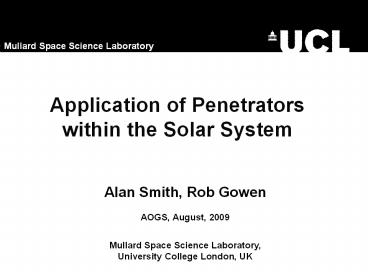Application of Penetrators within the Solar System - PowerPoint PPT Presentation
Title:
Application of Penetrators within the Solar System
Description:
Mullard Space Science Laboratory. Mullard Space Science Laboratory ... Chemical sensors Examine/identify refractory/volatiles (including water ice) ... – PowerPoint PPT presentation
Number of Views:52
Avg rating:3.0/5.0
Title: Application of Penetrators within the Solar System
1
Application of Penetrators within the Solar System
Alan Smith, Rob Gowen AOGS, August,
2009 Mullard Space Science Laboratory,
University College London, UK
2
Penetrators
- Low mass projectiles
- High impact speed up to 400 ms-1
- Very tough 10-50kgee
- Penetrate surface and imbed therein
- Undertake science-based measurements
- Transmit results
3
Typical Penetrator delivery
Delivery sequence courtesy SSTL
Operate from below surface
4
Why penetrators ?
- Advantages
- Simpler architecture
- Low mass
- Low cost
- Explore multiple sites
- Natural redundancy
- Direct contact with sub-regolith (drill,
sampling) - Protected from environment (wind, radiation)
- Limitations
- Low mass limits payload options
- Impact survival limits payload option
- Limited lifetime
- Limited telemetry capacity
Complementary to Soft Landers for in situ studies
5
Penetrator Payload Instruments
- Accelerometers Probe surface/sub-surface
material (hardness/composition) - Seismometers - Probe interior (e.g. Regolith
thickness, interior structure, existence/size of
water reservoirs, ...) and seismic activity of
bodies (location of quake sites, intensity and
frequency) - Mass Spectrometers Determine elemental
composition of surface material - Chemical sensors Examine/identify
refractory/volatiles (including water ice) with
possible astrobiologic significance - Thermal sensors - Heat flow, subsurface
temperatures and thermal conductivity. - Plus
- Magnetometer, Neutron spectrometer, XRS, gamma
ray spectrometer, alpha-proton spectrometer,
sample camera, beeping transmitter, radiation
monitor
6
Key Enabling Technologies
- Penetrator Descent Modules De-orbit, attitude
control to give a few km accuracy landing
ellipse. - Penetrator Power sub-system Lithium batteries
(baseline), RTGs, fuel cells - Penetrator Communications Penetrator Orbiter
comms, UHF, low power - Penetrator Architecture / Infrastructure
Modularity, Integration, central processor and
controller, robust clock - Penetrator Thermal Control - Insulation and
thermal design, RHUs. - Penetrator Sample Acquisition Drill, impact
scoop, sample handling - Descent Camera Impact site context, requires
despin and comms link - Penetrator PDM integration Shared resources,
separation - PDM Spacecraft release spin up on release?
7
Heritage
Military Heritage in instrumented impact
projectiles Numerous laboratories looking at high
velocity impacts with gas guns
QinetiQ
1996 Mars96 (Russia/Lavochkin), 2 off, 60-80
ms-1 impact, each 65kg incl braking system. Lost
when Mars96 failed to leave Earth orbit. 1999
Deep Space-2 (NASA/JPL), 2 off, 140-210ms-1
impact, each 3.6kg with entry shell. Failed,
cause unknown.
Lunar A (Japan/JAXA), 2 off, 285 ms-1 impact,
each 45kg including de-orbit and attitude
control. Programme terminated before launch after
extensive development and trials Lunar Glob
(Russia/Lavochkin), status unclear but may
include Lunar-A penetrators
2008 UK Penetrator Pendine Trials, 3 off, 300
ms-1 impact into compacted sand, each 13kg,
demonstrated survivability of a range of key
technologies in preparation for MoonLITE
8
Opportunities
Status
MoonLITE (UK) Lunar Glob (Russia)
UK/NASA agreed to full Phase A Kick-off postponed
until April 10
Penetrators (2018) now being considered as an
option in light of likely ExoMars rethink. Some
UK Aurora money now funding key instrument
developments
Mars Aurora (ESA)
Penetrator under consideration in ESA assessment
study. ESA contract ITT for system level study
JGO (ESA)
UK preparing input to NASA AO
JEO (NASA)
9
Ganymede
Galileo spacecraft image (NASA/JPL)
- Largest Moon of Jupiter
- Magnetosphere
- Water/rock surface interior
- Possible astrobiology
80km
A sharp boundary divides the dark Nicholson Regio
from the bright Harpagia Sulcus
10
- Basic parameters
- mass 0.7 Moon
- surface gravity 0.8 Moon
- radius 0.9 Moon
- surface temp 40-120K
- surface radiation Mrads
- near surface ocean?
- potential for life?
Europa
11
From Proctor (JHU), Patterson (APL) Senske
(JPL) (2009, Europa Lander Workshop, Moscow)
12
? developments required for Europa(beyond
MoonLITE)
- Impact (hard,rough)
- Radiation
- Planetary protection
- Transmission
- Long cruise phase
13
Penetrator Consortium
- March 2008 UK only
- Institutes 9 UK
- Members 30
- July 2009 UK European additions
- Institutes 16 UK
EU (Belgium, Germany, Italy, Austria, Spain) - Members 64 UK(50) EU(14)
Plus interest from various US institutes
14
Impact Trial
15
Previous Development Status last March
- QinetiQ responsible for
- penetrator outer fabrication
- Accelerometer and batteries
- Running the trial
- MSSL responsible for inner compartments
fabrication - - inner compartments all machined.
- MSSL electronics mostly fabricated undergoing
testing - Other payload providers participating.
- Trial was in 6 weeks time at Pendine.
Full-scale structure impact trial Scheduled May
19-23 2008
5 inner compartments within each penetrator
16
Impact Trial - Configuration
- Rocket sled
- Penetrator
17
- Impact trial Payload
- Mass
- spectrometer
- Radiation sensor
- Batteries
- Magnetometers
- Accelerometers
- Power
- Interconnection
- Processing
- Micro-seismometers
- Accelerometers, Thermometer
- Batteries,Data logger
- Drill assembly
18
MSSL accelerometer data
11 kgee
Peak gee forces in rear of penetrator
Along axis
Girder
Main impact
cutter
15 kgee
Vertical axis
- Along axis
- Cutter 3kgee
- Main 10kgee
- Girder 1kgee
4 kgee
Horizontal axis
19
Survival Table
No critical failures
20
(No Transcript)
21
Real-Time Impact Video
22
End
http//www.mssl.ucl.ac.uk/planetary/missions/Micro
_Penetrators.php Contact as_at_mssl.ucl.ac.uk
23
MoonLITE
3
- SpacecraftLunar polar orbit, altitude 100km,
lt40km for penetrator release.Potential ILN
comms link - Payload4 descent modules, each to implant a
13Kg penetratorat 300m/s into lunar surface - Landing sites Globally spaced - far side,
polar regions, near side - Launch Duration Planned for 2014 1 year
operations - Objectives
- network seismology
- polar water and volatiles
- ISRU (water/radiation/quakes)
4
Far side
2
1

